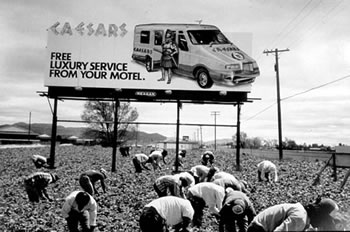“ What’s
documentary about photography?:
From directed to digital photojournalism ”
by John Mraz
Mexican
Migrant Workers, Highway in California.
Pedro Meyer © 1986/90
|
-----
Digitalization is the prime suspect in the much-discussed death of photojournalism and crisis of documentary photography (though “the end of photography as evidence of anything” is surely one among many instances of the postmodern retreat from the referent). Notwithstanding the undeniable impact of computerization on the credibility that is photojournalism’s bedrock, the unavoidable fact that so many of the most famous documentary images were somehow directed problematizes the effect of digitalization; it also offers insight into a worldview that has been quick to accept pictures as “candid” or “spontaneous,” when they were really constructed by photojournalists trading on the documentary aura.
I use the word “directed” to describe the genre of photojournalism characterized by the photographer’s intervention in the scene he or she is photographing, though the term “quasi-journalistic” might be more exact, since these individuals are working within the notions of non-interference and believability that reign in the contexts of news imagery. The following panorama of the more renowned cases of photographic direction offers a royal road through which to examine questions of authenticity and alteration, and to later extend it to the issues raised by digitalization.
I am here concerned with documentary photography and photojournalism, rather than what would be considered openly manipulated photography. Documentary credibility is based on the belief of nonintervention in the photographic act, and its discourse is structured into “codes of objectivity” that veil the effect of the photojournalist’s presence (Schwartz 1992). Conversely, expressly constructed photography explicitly announces that it has been created by an image-maker, thus establishing itself-the-photograph as a reality, while asserting that it is an illusion to believe that a photograph can show the real world.
It appears that O.G. Rejlander and H.P. Robinson made the first overtly fabricated photographs in the 1850s, and this genre has enjoyed a rich history as what we might call a “constructivist” alternative to the “realist” esthetic that has largely dominated photography. Among its many manifestations can be found the Pictorialist school of the 1890s, the photomontages of artists such as John Heartfield, the photograms of László Moholy-Nagy, the Dada-Surrealist experiments of Man Ray and, during the last thirty years, the Conceptual, Neo-Surrealist and Constructed imagery with whom we most often associate artists such as Duane Michaels, Les Krims, Cindy Sherman, and Joel-Peter Witkin.
The very thrust of explicitly manipulated photography is to critique the idea of realism, that a photograph is a window onto the world. As photojournalism is the medium that most embodies this ideology, artists such as Nic Nicosia have focused their efforts on exposing the illusions of graphic reportage by staging scenarios such as Like Photojournalism (1986), which recreate the violent and sanguinary scenes in which press photographers sometimes appear as part of the scenario.
Photojournalists have directed images in a variety of ways. In describing this genre, I have opted for a thematic approach, organized in a rough chronological order. Some of the categories I employ are well known within the study of art history, and have been utilized in analyzing constructed photography: the strategies of creating and/or restaging “living landscapes” (what art historians call narrative tableaux vivants), as well as arranging and/or rearranging still lifes. Other groupings have been suggested by photojournalist practices: the intervention in “real” events, and the use of “catalysts” to provoke reactions that the photographer has reason to expect will occur in “reality.”
